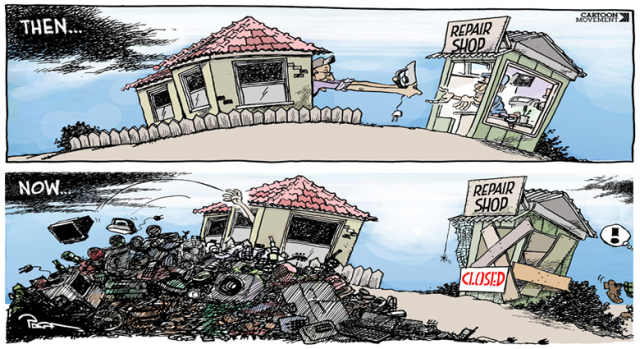Accidents happen. All of us have been there or at least know someone who’ve spilled a hot tea or coffee over their laptop or dropped the mobile phone into the toilet. However, most people dispose of their mobile or laptop because they want to upgrade to a new one.
For many, it could just be that the battery life has dropped down too low and rather than buying a new battery they just want a newer laptop.
Whatever the case, these are the steps you can take when your computer or laptop stops working or it’s time for a replacement.
1. Attempt to repair it
There are plenty of IT shops and newly, Repair Cafes are popping up everywhere around Perth. We know it’s not always easy or the cheapest to repair but it doesn’t hurt to try. For the sake of our planet. Remember, it goes: Reduce, Reuse, Recycle!
2. Attempt to upgrade it
We are sold the idea that each new generation of laptops and computers comes with amazing gadgets and capabilities. But have you ever asked in the shop – “How is this laptop better than my current one?”
According to Moore’s Law, the number of transistors on a microchip doubles every two years, though the cost of computers is halved. Moore’s Law states that we can expect the speed and capability of our computers to increase every couple of years, and we will pay less for them. Another tenet of Moore’s Law asserts that this growth is exponential.
 But here is the catch! Experts agree that computers should reach the physical limits of Moore’s Law at some point in the 2020s.
But here is the catch! Experts agree that computers should reach the physical limits of Moore’s Law at some point in the 2020s.
As we are now approaching the end of the growth phase, the new laptop or mobile phone you’re buying may have a fancy new camera or a bigger screen but its capability hasn’t approved that much.
So next time you go shopping ask yourself: “Do I really need a new one?”
3. Donate it for refurbishment
There are plenty of people who could benefit from a used laptop or computer. Maybe you have a friend or a relative who would consider your item an upgrade?
There might be a local organisation in your neighbourhood that would be grateful for your still usable item. Or you could look up a specialised charity such as GIVIT whose sole purpose is connecting donors with people in need.
We often team up with charities to donate large volumes of electronics we refurbished to deliver them into remote areas of WA and organisations that can’t afford IT infrastructure of their own.
4. Find your nearest recycling drop-off point
Call your local council or find your nearest drop-off point and take your no longer functional items there. Ask these 6 questions to ensure your e-waste is not exported illegally or send over-east to recycle.
Why are only some items free to recycle
The National Television and Computer Recycling Scheme (NTCRS) was established in 2011 to provide Australian households and small businesses with access to free industry-funded collection and recycling services for televisions and computers, including printers, computer parts and peripherals. The Product Stewardship (Televisions and Computers) Regulations 2011 provide the legislation for the scheme. (More about that later.)
To make the scheme easy to implement, the scope was limited to televisions, computers and computer peripherals like printers and screens.
Since then, there have been many recommendations to expand the scheme to cover ALL electronic and electrical items. The piece of literature is in front of Sussan Ley and we are eagerly awaiting the results of the five-year review.
Have you already paid for your item to be recycled?
Now you may not know, but if you have purchased a new computer, television or printer in the past 8 years since the NTCRS was introduced, then the chances are you have already paid for the costs of recycling in the price of your new computer.
The reason is that the Product Stewardship (also known as extended product responsibility = EPR) basically puts the responsibility for the item produced and brought into Australia on the manufacturer of that item. This means that companies like Dell, Apple, Microsoft, Toshiba etc. who import over a certain amount of items per year have to pay into the scheme to ensure their products can be taken care of sustainably at the end of their lives.
The threshold amounts are:
- 5000 units of televisions
- 5000 units of computers or printers
- 15,000 units of computer parts or peripherals.
Hence since you may have already paid for your item to be recycled, you may as conveniently drop off your old e-waste for free at your nearest recycling centre next time you’re passing by.
If you’d like to learn more about Where to drop off your e-waste or What constitutes e-waste, go on our website or Social media or to our Video Library to watch our other educational videos.
Please let us know any questions you may have.


